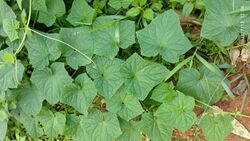Biology:Cucumis prophetarum
| Cucumis prophetarum | |
|---|---|

| |
| Leaves of Cucumis prophetarum | |
| Scientific classification | |
| Kingdom: | Plantae |
| Clade: | Tracheophytes |
| Clade: | Angiosperms |
| Clade: | Eudicots |
| Clade: | Rosids |
| Order: | Cucurbitales |
| Family: | Cucurbitaceae |
| Genus: | Cucumis |
| Species: | C. prophetarum
|
| Binomial name | |
| Cucumis prophetarum L. (1759)
| |
| Subspecies | |
| |
| Synonyms | |
| |
Cucumis prophetarum is a dioecious and prostrate or climbing perennial vine in the family Cucurbitaceae.[1] The specific epithet (prophetarum) comes from Latin propheta, meaning "prophet".
Distribution
Cucumis prophetarum is native to Africa and the Middle East, from Mauritania east to the Horn of Africa and southwest to Angola then southeast to South Africa, as well as Israel south to Yemen and Oman and east to northwestern India . It has been introduced to Qatar.[2] It grows wild in semi-desert bushland and grassland up to 6,594 feet (2,010 meters) in elevation, often with acacia trees.[3]
Description
Its stems and leaves are hairy and the leaves are ovate to round in shape and cordate at the base and measure 2–4 centimeters in length. The margins are dentate or lobulate. They have 3–5 blunt-toothed, obtuse or subacute lobes, and the petioles measure 6–87 millimeters (0.24–3.43 inches) in length. Male flowers occur in clusters of 2–3 on pedicels measuring 3–25 millimeters (0.12–0.98 inches) in length, and are rarely solitary. Female flowers are always solitary and have peduncles measuring 6–30 millimeters (0.24–1.18 inches) in length. They have five yellow petals measuring 5–8 millimeters in length and 2.5–3.5 millimeters in width. The fruit is slightly ovoid and is vertically striped and yellow in color when ripe. It measures 3–4 centimeters in length and is covered in spike-like pustules.[4]
Uses
The fruit has a bitter flavor when raw and is sometimes boiled or pickled and the leaves are cooked and served with a staple.[3] The fruit is eaten across its native range and occasionally cultivated and sold in local markets.[3]
The fruit is also used in folk medicine in Saudi Arabia to treat liver disorders and an extract from it has been proven to contain cytotoxicity against six cancer cell lines.[5] Another extract from the fruit induces an anti-diabetic effect.[6]
See also
- List of culinary fruits
- List of culinary vegetables
References
- ↑ "cucumis – Encyclopedia of Life". https://eol.org/pages/483976.
- ↑ "Cucumis prophetarum L.". https://www.gbif.org/species/2874576.
- ↑ 3.0 3.1 3.2 "Cucumis prophetarum – Useful Tropical Plants". http://tropical.theferns.info/viewtropical.php?id=Cucumis+prophetarum.
- ↑ "Cucumis prophetarum – Wild Gourd". http://www.flowersofindia.net/catalog/slides/Wild%20Gourd.html.
- ↑ "Isolation of anticancer constituents from Cucumis prophetarum var. prophetarum through bioassay-guided fractionation". BMC Complementary and Alternative Medicine 18 (1): 274. October 2018. doi:10.1186/s12906-018-2295-5. PMID 30301463.
- ↑ Kavishankar, G. B.; Lakshmidevi, N. (15 April 2014). "Anti-diabetic effect of a novel N-Trisaccharide isolated from Cucumis prophetarum on streptozotocin-nicotinamide induced type 2 diabetic rats". Phytomedicine 21 (5): 624–630. doi:10.1016/j.phymed.2013.12.002. PMID 24462215. https://pubmed.ncbi.nlm.nih.gov/24462215/. Retrieved 20 January 2021.
Wikidata ☰ {{{from}}} entry
 |



